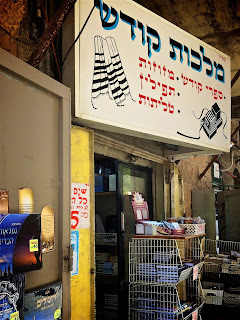Sochrim: Retailers, Dealers & Other Middlemen
| This series of blog posts can be downloaded as a free ebook.1 For a brief overview of the complete series, including links to all the posts, see Purchasing STAM: Index & Summary. |
The last few posts in this series discussed the creation of STAM – the people who manufacture the various parts and the methods and materials they use. This post will address the buying and selling of STAM and the merchants who are often the only public face of the STAM industry.

Most people who buy STAM do not go directly to a sofer to commission the work. Instead, they go to a retailer who buys STAM from many different sources and sells to the general public. This gives sofrim an opportunity to sell to a wider market than they would otherwise be able to access, and it gives buyers a central location to fill their STAM needs without having to go hunting around for a sofer.
In essence, buying STAM from a retailer or dealer is taking a huge leap of faith – much more so than when buying directly from a sofer. When buying from a sofer, you are dealing with one person. If you don’t know the sofer personally, you can ask a rabbi or other knowledgeable person if he is reliable, and, if you are satisfied with the answer, you can buy with confidence. When you buy from a socher, even one who is known to be reliable, you are trusting that every single sofer, magi’ah, klaf-maker, batim maker and retzu’os maker that he deals with, as well as all of their employees, are entirely trustworthy. This is easily dozens of people and for a large-volume retailer it can even be hundreds of people. If even one person in the supply chain is not reliable, every single item in the socher’s inventory is now suspect.
The enormous responsibility that the socher carries also makes it necessary that the socher himself be an expert in all areas of hilchos STAM. This is self-evident – the socher must evaluate every item he buys to determine its status: Is it kosher or pasul? Is it bidi’eved or lechatchila or mehudar? It is not possible for a socher to make these distinctions unless he has the halachic background to differentiate between them.
The customer always assumes that the STAM he is buying is at the very least kosher. If the retailer tells the customer that he is selling him an item that is “mehudar”, the customer feels justified spending more money for a better product. A retailer who is not himself an expert in hilchos STAM can not honestly make any guarantees as to kashrus level of his stock.
The sad fact is, most of the people selling STAM today are not experts in hilchos STAM. By way of example, a significant percentage of the mezuzos on the market are sold in “Judaica stores”. Some of these shops are simply bookstores catering to the religious Jewish market. Some of the stores are really arts & crafts galleries – they sell decorative items for ritual use. A bookstore is a fine place to buy a book on the laws of mezuza. A store that sells primarily framed prints and kiddush cups is a great place to buy a mezuza case. Neither store is the ideal place to buy a mezuza itself (or any other STAM item).

Even when dealing with a retailer who is an expert in the laws of STAM, there is another potential pitfall; as noted in the first post in this series, the competition in the STAM market is strong. A retailer who is an expert in STAM still has to compete with the Judaica gallery down the block which is selling pasul mezuzos as “kosher” and bidi’eved mezuzos as “mehudar”. Even if the retailer is an honest person who would never knowingly sell something pasul, he may use phrases like “basic kosher” when labeling STAM that is only kosher bidi’eved, and he might say “the writing is mehudar” when describing a handwriting sample that is aesthetically beautiful but may have minor halachic deficiencies.
The average STAM-buyer has only two ways to protect himself and increase the odds that he is getting what he paid for. The first is to properly research the dealers. Ask around; talk to rabbis and STAM professionals. Find out where knowledgeable people buy STAM for their own families. Get recommendations from as many good sources as possible – some sochrim will get praised more than others.
After doing the legwork and getting solid recommendations from multiple sources, the next step is to take the STAM for independent third-party verification. Any decent magi’ah should be able to give a fairly good estimate of the value of a given piece of STAM, as well as evaluate its halachic status. The inspection may not be free, but it is a small price to pay for the peace of mind that comes from knowing that the STAM is kosher at a level and price that is within the buyer’s comfort zone. If the seller is unwilling to let the buyer take the STAM item for an independent examination then the buyer should take his business elsewhere.
This post made several references to the halachic quality of STAM: bidi’eved, lechatchila, and mehudar. The next post in this series will define the different levels as they relate to STAM.
-= 8 =-
-
The blog posts have been revised to reflect edits and corrections made when preparing the ebook edition. ↩
